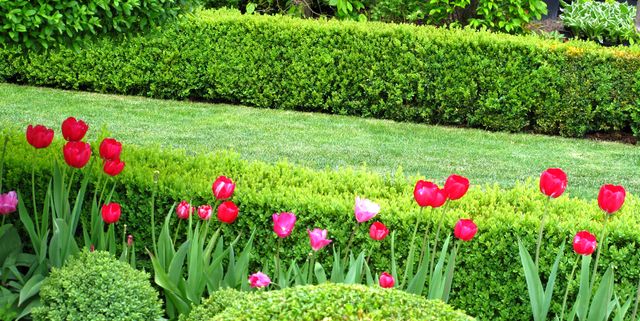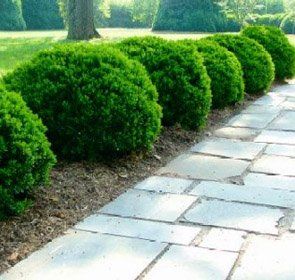According to a survey of 4,000 landscape professionals, boxwood (Buxus) is the most popular shrub in America. And yet, about a decade ago it was nearly impossible to find boxwoods at home-improvement stores. Why the sea change? Boxwoods were probably unpopular because the foliage's odor can be off-putting, but as deer populations have increased, this predator-resisting attribute has become an advantage.
A tip to keep boxwood healthy is to avoid planting them too deeply. If anything, plant the crown — the spot where the roots flare from the stems — an inch higher than it grew in the nursery. They prefer well-drained soil that is neutral to slightly alkaline. Mulchwith an inch or so of chopped leaves to help keep soil cool (but don’t heap mulch against the stems).
Once established, boxwood shrubs are very drought-tolerant. Most cultivars will grow in full sun to a half day of shade. And many, despite their malodorous reputation, have delightfully fragrant little flowers.
The plants we hoped would be all-round problem solvers have a new problem, however: a fungal disease called boxwood blight (Cylindrocladium buxicola), which has been found in an increasing number of states and for which there is no cure. Symptoms appear initially as brown spots on leaves that enlarge until the entire leaf turns dead and dry. Nearly black vertical lesions appear on the stems. Trimmed plants may attempt to push new growth, but that too is soon attacked.
"I think the problem is cultural," says Andrea Filippone, owner of AJF Design in Pottersville, New Jersey. "Growers are using too much nitrogen, fungicide, and overhead watering." She has talked to several nurseries, but they are reluctant to respond. "They are just using more fungicides."
And she knows, having been a director of the American Boxwood Society. Filippone grows and tests dozens of boxwood cultivars in her gardens and in a large nursery area, learning as much as she can about the performance, habit, and ruggedness of Buxusspecies.
To prevent any plants she buys from spreading the fungus to her garden, Filippone quarantines new plants in a nursery bed — although not the most practical thing for home gardeners. She uses compost tea and drip irrigation to help maintain their health.
For centuries, the most popular cultivar grown has been the so-called English boxwood (Buxus sempervirens Suffruticosa), a slow-growing dwarf with small leaves. This cultivar is actually a poor choice, since it is incredibly susceptible to a host of diseases. Filippone recommends Buxus sinicavar insularis Justin Brouwers as an alternative.
Often, plants in the big-box stores labeled "English Box" are not Suffruticosa. The word English sells. These plants often seem to be Buxus sempervirens. "English" and "American" are misnomers — the species originated in Eurasia.
Here is a list of some boxwood cultivars and their characteristics. Height and spread are approximate for plants at maturity, about 15 years of age. The American Boxwood Society has more information on growing boxwood.
Small-Leaved Boxwood
Buxus microphylla
- Grace Hendrick Phillips: very dwarf; 1 × 2 foot; zones 6–8
- Compacta (Kingsville Dwarf): the smallest of them all, tiny leaves, dense, very slow; 1 × 1.5 foot; zones 6–8
Japanese Boxwood
Buxus microphylla var. japonica
- Green Beauty: deep green, responds well to pruning, a good substitute for English box; 3 × 3 feet; zones 6–8
- Morris Dwarf: slow, formal hedge for sun; 1 × 1 foot; zones 6–8
- Morris Midget: very dwarf, small leaves, sun tolerant; 1 x 1 foot; zones 6–8
- Wintergreen: cold-hardy, good for hedge, fast-growing; 4 × 4 feet; zones 5–8
Common or American Boxwood
Buxus sempervirens
- B. sempervirens: called American boxwood, tall, tried and true species; 5 × 4 feet; zones 5–8
- Dee Runk: upright fast growth; 8 x 2 feet; zones 6–8
- Elegantissima: best variegated gray-green and cream, disease-resistant; 3 × 2.5 feet; zones 6–8
- Fastigiata: bluish-green upright growth for hedge; 8 × 3 feet; zones 6–8
- Graham Blandy: most narrow columnar, better in cold climates, may need tying or pruning; 7 × 1 feet; zones 5–6
- Jensen: similar to English; 2 × 2 feet; zones 6–8
- Newport Blue: globular, quite blue-green foliage; 4 × 3 feet; zones 6–8
- Pyramidalis: upright cone; 8 × 4 feet; zones 6–8
- Rotundifolia: fast growing, largest leaves, shade tolerant; 5 × 4 feet; zone 6
- Vardar Valley: disease-resistant, bluish new growth, hardy; 1 × 3 feet; zones 5–8
- Wanford Page: long-lasting chartreuse new growth then leaves mottled green and yellow, dwarf; 2 × 1.5 feet; zones 6–8
Korean Boxwood
Buxus sinica var. insularis (B. microphylla var. koreana)
- Justin Brouwers: sun to shade, natural globe; 2 × 2 feet; zones 6–8
- Nana: spreading dwarf with narrow leaves, chartreuse in spring, slow; 1 × 3 feet; zones 6–8
Hybrid Boxwood
Buxus hybrids
- Glencoe: selected at Chicago Botanic Garden, container plant, edging, hardy; 4 × 5 feet; zones 4–8
- Green Mound: sun to shade, globular, hardy; 2 × 2 feet; zones 4–8
- Green Mountain: upright, conical, hardy; 4 × 3 feet; zones 4–8
- Green Velvet: lime green spring growth, mounding, hardy, 2 × 2.5 feet; zones 4–8














